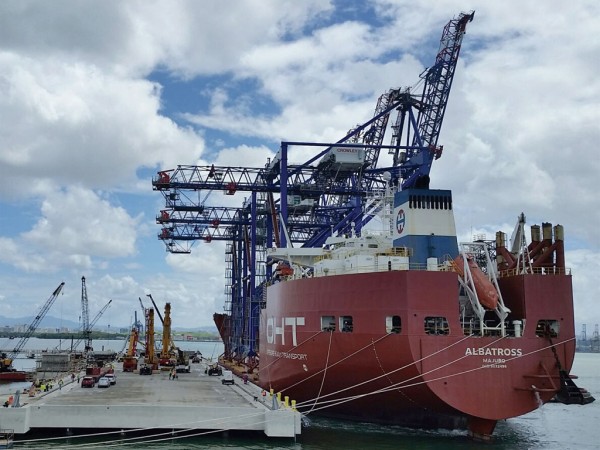Electricity infrastructure, still not fully restored, will likely fail again in another storm
On June 14, 2018, the Puerto Rico Department of Health took delivery of three portable medical units provided by Clinics on Wheels, a new division of World Housing Solution Inc., to aid those still affected by Hurricane Maria. The solar-powered units were designed as a general medical clinic with x-ray, an OB-Gyn/pediatric clinic, and a dentist’s office. The clinics were transported by pick-up trucks and equipped with a solar/batteries/generator power system. The deliveries, headed for Vieques, were made possible through funding from the Federal Emergency Management Agency (FEMA).
Rebuilding Puerto Rico
The event is emblematic of the ongoing effort to rebuild Puerto Rico in the aftermath of last September’s Hurricane Maria. The destruction of the electrical grid was one of the major consequences of the storm and the lack of electricity is likely one of the major factors contributing to the finding of a recent study published in the New England Journal of Medicine that over four-thousand deaths can be linked to the storm and its immediate aftermath—not the official death toll of a few dozen. And, despite $3.8 billion having been spent fixing the electricity grid, USA Today recently reported that 11,000 people were still without power.
The United States government has been criticized for failing to allocate sufficient resources to the rehabilitation project. But at the same time, several private U.S. transportation and logistics providers exerted efforts to bring life on the island commonwealth back to normal. Three companies that stepped up to help bring Puerto Rico back were Crowley Merchant Marine, Lynden, and TOTE Maritime.

“In preparation for Hurricane Maria and at the direction of FEMA, Crowley prepositioned supplies from Puerto Rico to different sites within the U.S. Virgin Islands,” said Dan Warner, Crowley’s senior vice president and treasurer. Crowley also prepositioned vessels that could respond as soon as Maria passed, and carried 2,200 containers of food and aid cargo, as well as commercial goods, in an immediate response to the storm.
TOTE Maritime’s efforts also began before Hurricane Maria made landfall on September 20 with the positioning of ships. “In the days immediately following the Hurricane, TOTE delivered 2,000 containers to the island and added additional capacity to the trade to support the immediate and diverse needs of the island following the storm,” said Eduardo Pagan, TOTE’s vice president and general manager for Caribbean services. “Food, fuel, ice, oxygen, generators, water filters, batteries, utility trucks, toys for the holidays, relief goods such as flashlights and medicine” were among the products delivered.
Even before San Juan harbor reopened, Lynden flew in supplies via chartered aircraft and their own L-382 Hercules aircraft, with the primary mission of helping its employees and customers. “We needed to get the lives of our employees back in order, which was a challenge,” said John Kaloper, president of Lynden International, part of the Lynden family of companies. “We delivered everything from bottled water to fuel for outdoor cook stoves to D-cell batteries, anything they needed to survive without electricity or running water.”
The company also delivered over 500 portable generators to employees and customers, which include pharmaceuticals and retailing companies. Lynden also provided services to the U.S. government and to relief agencies, delivering bottled water and construction supplies on their behalf.
“Initially, this was an effort to get lives back in order,” said Kaloper. “Later it became getting the commerce piece back up and running.”
Retailers often found that 50% or more of their stores were significantly damaged. To help in this effort, Lynden delivered several oversize generators to Puerto Rico, requiring the chartering of Antonov 124 aircraft.
Crowley unloaded over 200 vessels in the first six months after the storm, with cargo consisting of 40,000 commercial loads and 8,000 government loads, for a total of 100,000 TEU and 3,500 breakbulk shipments. Cargoes have included utility poles, electrical transformers, 10 million miles of electrical utility cable, 3,200 containers of water, and 1,200 containers of food. Crowley also transported bridge sections to Puerto Rico to support roadway reconstruction in the Utuado region.
To make all that happen Crowley expanded its fleet from nine to 16 vessels, including the addition of two company-owned heavy-lift barges. The company sourced equipment as far away as the Midwest, adding 5,000 extra containers and hundreds of additional chassis to its Puerto Rico equipment fleet and it doubled warehouse space on the island to alleviate delayed turn times.
“The larger fleet ensures almost daily vessel arrivals and it upped capacity by 67 percent,” said Warner.
The efforts of all three companies will continue for some time. “The complete rebuilding of Puerto Rico will take years,” said Pagan. “There are still some communities without power and rolling brown outs are not uncommon on the island.”
The Challenge of the Grid
Efforts to strengthen the electric grid will no doubt pose a continuing challenge. It turns out Puerto Rico’s electricity problems go back to before the devastation of Hurricane Maria. The Puerto Rico Electric Power Authority (PREPA) filed a bankruptcy petition a couple of months before the storm hit and the ratings service Fitch recently downgraded the authority’s bond rating to D. In evaluating the creditworthiness of AES Puerto Rico, L.P., a PREPA supplier with a 454-megawatt coal-fired power plant in Guayama, which Fitch rated as C, its report noted the real possibility of a payment default by PREPA and the possibility that PREPA could try to renegotiate the power purchase agreement between the two parties under the bankruptcy proceedings.
The Associated Press recently quoted officials as saying that Puerto Rico’s public electrical authority “is almost certain to collapse again when the next hurricane hits this island.” Given that assessment, it sounds like delivering portable medical clinics with their own built in power systems involved good timing.





